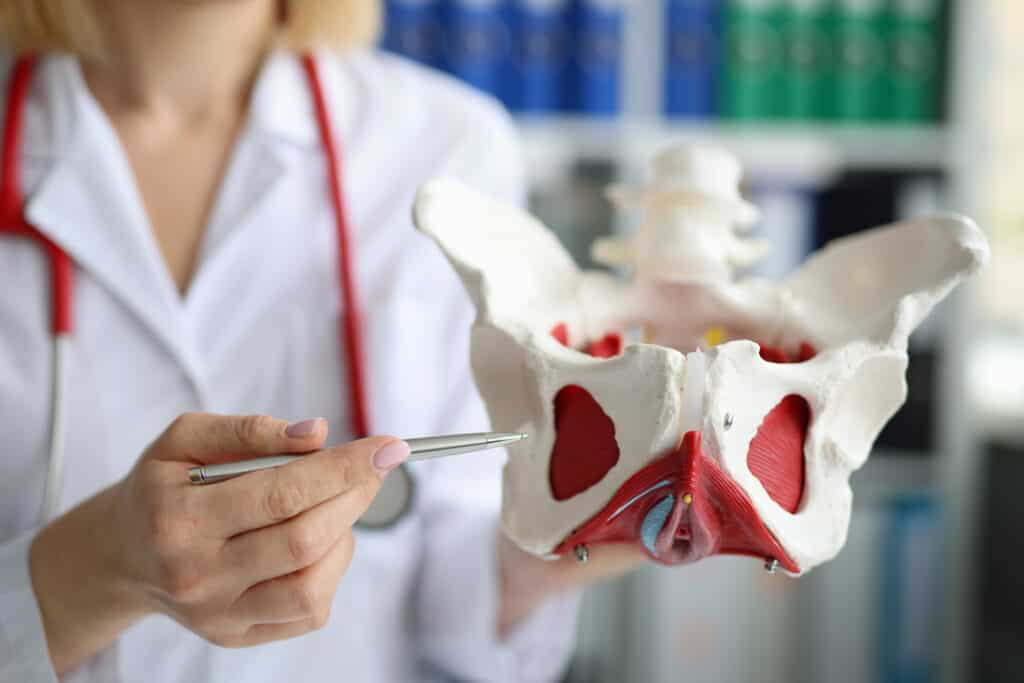
Have you heard other women talking about “Kegels” (and wondering whether you should be doing them too)?
Kegel exercises may sound more like something that you do in the gym rather than something you do while you're standing in line at the grocery store or lying on the couch.
But the truth is you can do them anywhere, and these clever little exercises (if done correctly) can significantly improve your sexual health and overall wellbeing.
So, whether you want to achieve better bladder control, have stronger orgasms and better sex– or both – you should seriously consider adding these easy-to-do exercises into your life.
But what are Kegels? How Do you do them correctly, and what are the benefits?
More Blogs From Nancy Branberg
What Are The Symptoms Of Pelvic Inflammatory Disease?
Hypertonic Pelvic Floor: Symptoms, Causes & Treatment
What’s Causing My Lower Abdominal Pain?
What Are Kegel Exercises, And What Are The Benefits?

Kegel exercises, also known as pelvic floor exercises, involve squeezing and relaxing the muscles that support your pelvic organs (your “pelvic floor”).
They are easy and can be done discreetly anytime, anywhere. The benefits of doing Kegel exercises regularly go beyond improving urinary incontinence and pelvic floor dysfunction.
Making them part of your daily life can give you a stronger, more functional pelvic floor and better all-around health.
They can also increase your sexual satisfaction by enhancing genital blood flow and muscle tone, improving your bowel function, and preventing pelvic organ prolapse.
How To Do Kegel Exercises (Correctly)
So, kegel exercises are a great way to build the strength of your pelvic floor muscles and improve bladder control. However, as with any exercise, you must do them correctly to reap the benefits.
But do you know which muscles you should engage to get the most out of your Kegel workout?
Are you doing them tight?
Here’s the inside “scoop”: The muscles you want to target during Kegel exercises are the same ones that stop urine flow or prevent you from passing gas (when you don’t want to).
These muscles are in your pelvic floor – running from your pubic bone to your tailbone. If you want to figure out if you’re engaging the right muscles, try stopping your urine midstream next time you use the bathroom. That squeezing sensation you feel is precisely what you want to feel when doing Kegels.
It's also essential to maintain your breathing and not hold your breath while doing Kegels and start slowly and gradually working up to more prolonged contractions and repetitions.
But with practice, you’ll be a Kegel expert in no time, and your pelvic floor will start to feel the benefits quickly.
How Often Should I Do Kegel Exercises To See Results?

The aim of Kegel exercises is to strengthen the pelvic floor muscles and improve pelvic health, bladder control, and sexual function.
But many women don't know how often they should do Kegel exercises to see these results. But as with many things relating to individual health, the answer to this question truly depends on your body and lifestyle and the severity of your current symptoms.
Some experts recommend doing Kegel exercises at least three times a day. In contrast, others suggest doing them during specific daily routines, such as brushing your teeth, which can help you remember to do them and make them a lasting habit.
The key is to be consistent in your practice, as it may take several weeks or months to significantly improve your symptoms.
But the good news is that you can do Kegel exercises any time, and only you know that you're doing them, so you can do them anywhere and at any point during the day/night; Sitting at your desk, in the car, or while standing in a queue, the choice is up to you.
But, again, consistency is key – aim to do your Kegels daily for optimal results.
How To Incorporate Pelvic Floor Exercises Into Your Daily Routine
The best thing about Kegel exercises (compared to other exercises you must schedule into your daily routine) is that you can do them anytime, anywhere.
Of course, the classic way to perform them is to squeeze your pelvic floor muscles for 5 seconds and then release for another five. But if you want to include them in your daily routine, many other creative options exist.
For example, you can do them every time the commercials come on while watching TV or at a stoplight. Alternatively, you can set a reminder on your phone to do them at specific intervals throughout your day.
It doesn't matter which method you choose; if you do them regularly, you'll soon be on your way to better pelvic health.
Are There Risks With Doing Kegel Exercises Too Often?

Along with Pelvic Floor Physical Therapy, we commonly recommend Kegel exercises to strengthen the pelvic floor muscles due to the many benefits and enhanced sexual health.
However, doing Kegel exercises too frequently can sometimes result in unwanted side effects. For example, overworked pelvic floor muscles can cause discomfort or pain and sometimes even the very symptoms you're trying to prevent, such as urinary incontinence.
So, it’s important to note that just like any other exercise, the intensity and frequency of Kegels should reflect your individual needs.
In an ideal world, we wouldn't recommend that you start Kegel exercises until you've had your current symptoms evaluated by a physical therapist to avoid potentially worsening things.
But with the proper guidance from a Pelvic Floor Physical Therapist, Kegels are safe and effective. As a result, we can help you improve and maintain your all-important pelvic floor strength.
As with all exercises, knowing the potential risks involved is vital and applying common sense when proceeding with any new activity or routine is vital.
With that in mind, take some time to experiment with different ways to introduce Kegel exercises into your daily life, such as doing them while commuting or during a lunch break at work.
As soon as you start feeling yourself become stronger, you'll see why this tried and tested workout has stood the test of time for so many years.
Why Is Pelvic Floor Physical Therapy Better Than Kegels?

For many women, strengthening their pelvic floor muscles seems like an easy task—just do your daily Kegel exercises and you'll be set, right? Not so fast.
While doing regular Kegels can improve the strength of your pelvic floor muscles, Kegels alone are often not enough to provide full relief of symptoms, which is where Pelvic Floor Physical Therapy comes in.
Pelvic floor physical therapy is a specialized form of therapy that helps with bladder and bowel incontinence, pain within the pelvic region, or difficulty with sexual intercourse, which can be due to weak pelvic floor muscles but can also be overly tight muscles.
So, it's important to get a physical therapist to evaluate what the problem is for you.
We can evaluate the muscles, ligaments, and connective tissues around your pelvic region to check for issues. Then use targeted exercises and hands-on techniques to correct those issues and improve your pelvic floor strength and flexibility, alleviate pain, and your overall pelvic and reproductive health.
So, while Kegels can be helpful, pelvic floor physical therapy offers a more comprehensive and personalized approach. We assess your needs and create exercises specific to you and your body.
We also educate you on properly engaging your muscles during daily activities like lifting or running.
During our sessions, you'll learn exercises to strengthen your pelvic floor muscles and improve your overall health.
While it may feel uncomfortable or embarrassing initially, remember that this type of therapy can significantly benefit your quality of life and overall wellbeing.
There are many benefits of regular pelvic floor physical therapy that go way beyond just relieving symptoms.
Unfortunately, many women believe pelvic floor therapy is just for urinary incontinence or pelvic organ prolapse. Still, there are a multitude of other benefits.
For instance, regular pelvic floor therapy can improve your posture, reduce the risk of injury, and even improve your athletic performance.
Strengthening your pelvic floor can also improve your overall quality of life and increase your confidence.
It's also an effective and accessible way to treat pelvic health issues that not only address existing symptoms but also attempt to prevent them.
Right from the first session, you will immediately feel the benefits.
Despite its recent emergence into mainstream medicine, pelvic floor physical therapy should be considered a cornerstone of overall healthcare because when your most intimate muscular systems function well, you can truly feel your best self.


